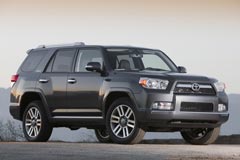 As consumers abandoned their station wagons in the mid 1980’s in favor of the more utilitarian car-truck hybrid that was introduced as the SUV, Toyota jumped on the bandwagon by launching its 4Runner line of SUV’s in 1984.
As consumers abandoned their station wagons in the mid 1980’s in favor of the more utilitarian car-truck hybrid that was introduced as the SUV, Toyota jumped on the bandwagon by launching its 4Runner line of SUV’s in 1984.
The first generation of 4Runners actually resembled a conventional pickup truck with a camper shell, but they offered the convenience of an SUV with the longevity that is a signature feature of Toyota.
The second generation (1989-1995) brought sleeker body styles that gave a unified appearance to the entire 4Runner. Although a few two-door models were produced, almost all second generation 4Runners had four-door design. They also used the same engine types as the first generation models.
The third generation (1995-2002) came with an overall redesign that added luxury features to the old model that was mainly utility-oriented. This caught the eye of consumers who were looking for functionality with enviable appearance in their vehicles.
Fourth generation (2002-2009) were designed with major changes to the chassis and body design, but still attracted the same demographics as the third generation models. Greater durability was the key component in these models.
The fifth, and current, generation (2009-present) boasts increased horsepower with the same eye appeal as its earlier models.
Fuel economy with functionality remains the consistent theme for all generations of 4Runners, along with the Toyota reputation for longevity that can span far beyond 200,000 odometer miles with regular maintenance and upkeep.
| 2013 Starting MSRP: $31,490 2012: $31,090 2011: $30,305 2010: $29,175 |
Estimated MPG: 17 City/22 Hwy |
| Available Trims: SR5, Trail, Limited | Base Engine: 4.0L V6 |